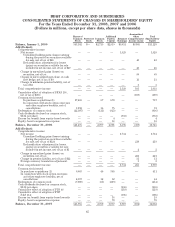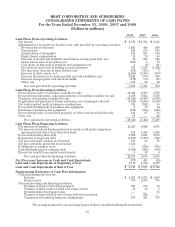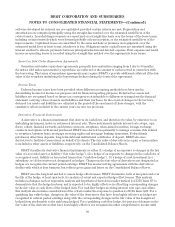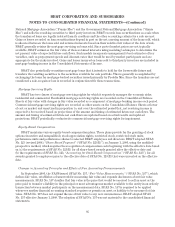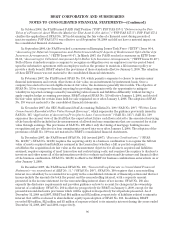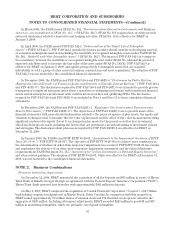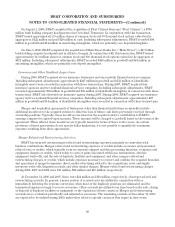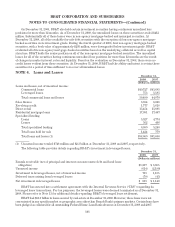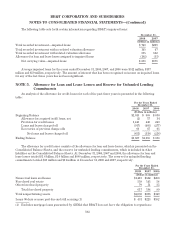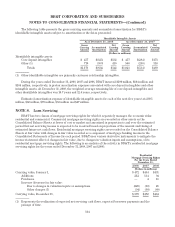BB&T 2008 Annual Report Download - page 94
Download and view the complete annual report
Please find page 94 of the 2008 BB&T annual report below. You can navigate through the pages in the report by either clicking on the pages listed below, or by using the keyword search tool below to find specific information within the annual report.BB&T CORPORATION AND SUBSIDIARIES
NOTES TO CONSOLIDATED FINANCIAL STATEMENTS—(Continued)
the related cash flows from the hedged item are recognized in earnings. For qualifying cash flow hedges involving
interest rate caps and collars, the initial fair value of the premium paid is allocated and recognized in the same
future period that the hedged forecasted transaction impacts earnings.
For either fair value hedges or cash flow hedges, ineffectiveness may be recognized in noninterest income to
the extent that changes in the value of the derivative instruments do not perfectly offset changes in the value of
the hedged items. If the hedge ceases to be highly effective, BB&T discontinues hedge accounting and recognizes
the changes in fair value in current period earnings. If a derivative that qualifies as a fair value or cash flow hedge
is terminated or the designation removed, the realized or then unrealized gain or loss is recognized into income
over the original hedge period (fair value hedge) or period in which the hedged item affects earnings (cash flow
hedge). Immediate recognition in earnings is required upon sale or extinguishment of the hedged item (fair value
hedge) or if it is probable that the hedged cash flows will not occur (cash flow hedge).
Derivatives used to manage economic risk not designated as hedges primarily represent economic risk
management instruments of mortgage servicing rights and mortgage banking operations, with gains or losses
included in mortgage banking income. In connection with its mortgage banking activities, BB&T enters into loan
commitments to fund residential mortgage loans at specified rates and for specified periods of time. To the extent
that BB&T’s interest rate lock commitments relate to loans that will be held for sale upon funding, they are also
accounted for as derivatives, with gains or losses included in mortgage banking income. Gains and losses on other
derivatives used to manage economic risk are primarily associated with client derivative activity and included in
other income.
Per Share Data
Basic net income per common share is computed by dividing net income available to common shareholders by
the weighted average number of shares of common stock outstanding during the years presented. Diluted net
income per common share is computed by dividing net income available to common shareholders by the weighted
average number of shares of common stock, common stock equivalents and other potentially dilutive securities
outstanding.
Goodwill and Other Intangible Assets
Goodwill represents the cost in excess of the fair value of net assets acquired (including identifiable intangibles)
in transactions accounted for as purchases. BB&T allocates goodwill to the business that receives significant
benefits from the acquisition. In accordance with provisions of SFAS No. 142, “Goodwill and Other Intangible
Assets,” goodwill is not amortized over an estimated useful life, but rather is tested at least annually for impairment.
BB&T performs its impairment testing in the fourth quarter of each year and more frequently if circumstances exist
that indicate a possible reduction in the fair value of the business below its carrying value. BB&T measures
impairment using the present value of estimated future cash flows. The analysis is based upon available information
regarding expected future cash flows and discount rates. Discount rates are based upon the cost of capital specific to
the industry in which the reporting unit operates. If the carrying value of the reporting unit exceeds its fair value, a
second analysis is performed to measure the fair value of all assets and liabilities. If, based on the second analysis, it
is determined that the fair value of the assets and liabilities of the reporting unit is less than the carrying value,
BB&T would recognize impairment for the excess of carrying value over fair value.
Core deposit and other intangible assets include premiums paid for acquisitions of core deposits (core deposit
intangibles) and other identifiable intangible assets. Intangible assets other than goodwill, which are determined
to have finite lives, are amortized based upon the estimated economic benefits received.
Loan Securitizations
BB&T securitizes most of its fixed-rate conforming mortgage loans, converts them into mortgage-backed
securities issued primarily through the Federal Home Loan Mortgage Corporation (“Freddie Mac”), the Federal
94



